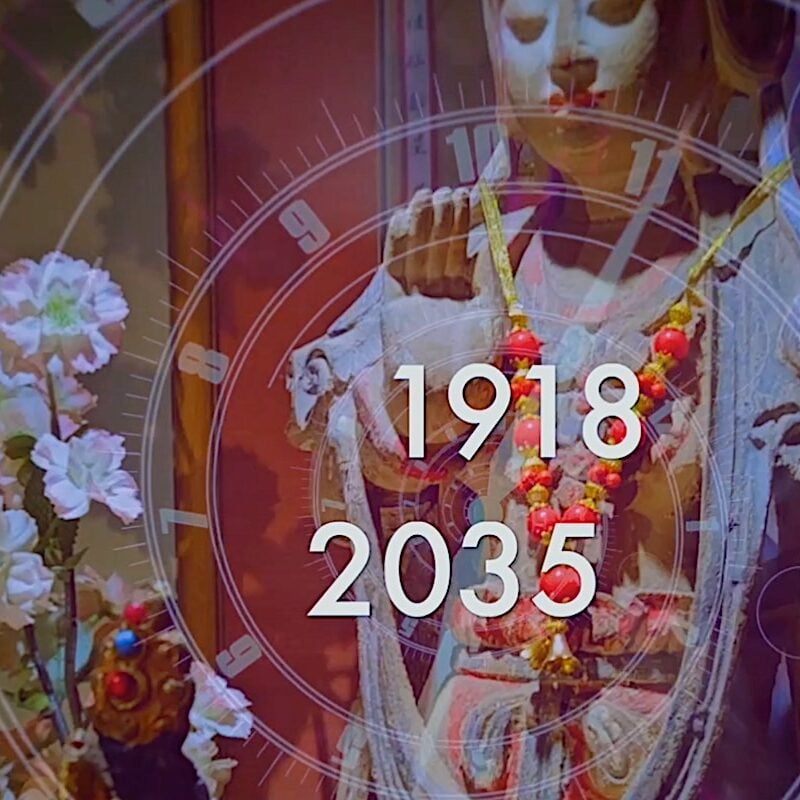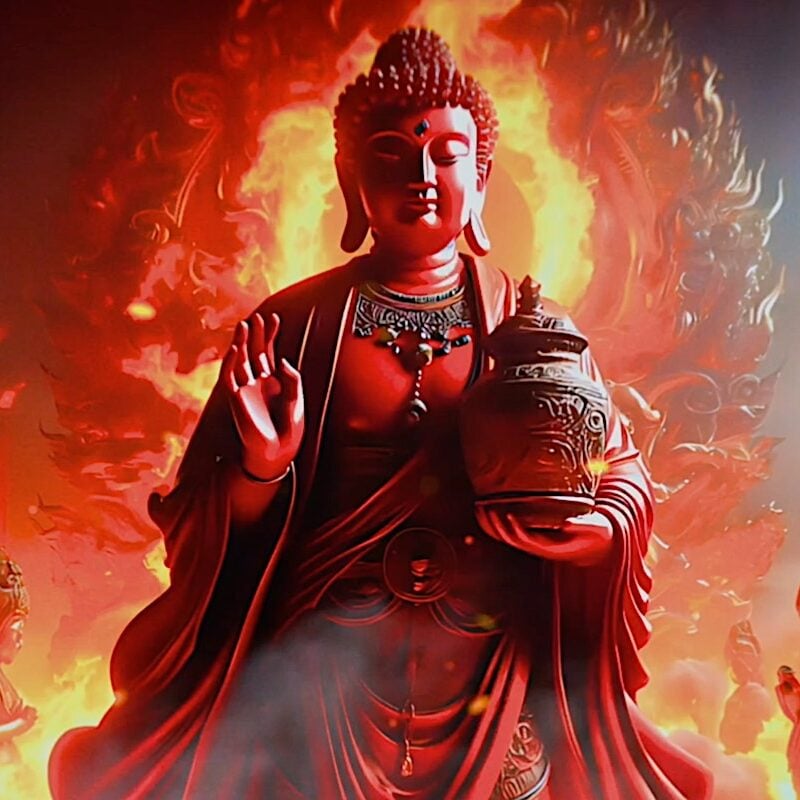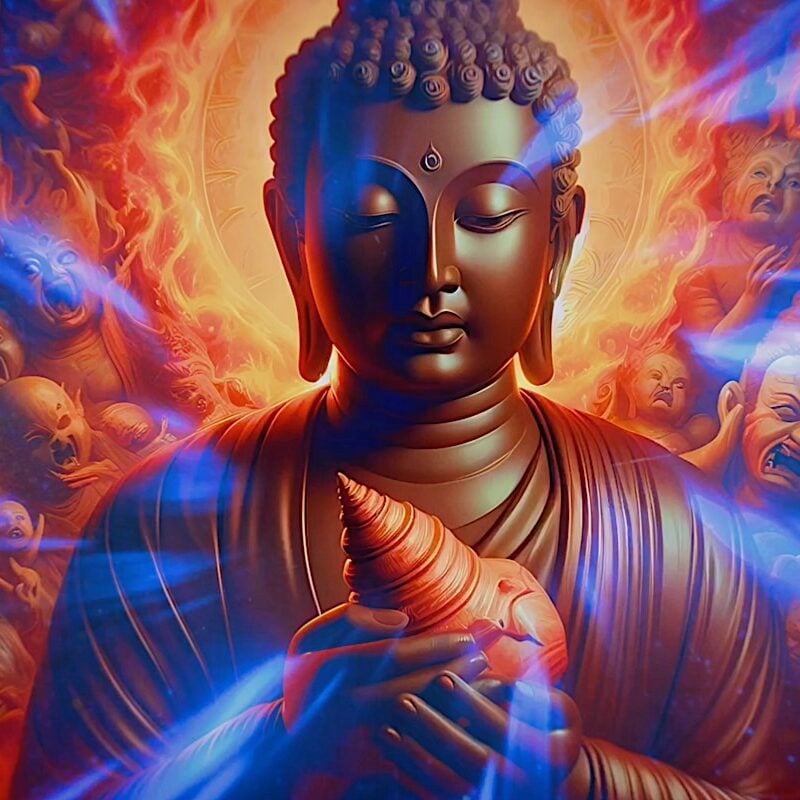A Better Way to Catch a Snake Sutra: Buddha explains the danger of misinterpreting the Dharma
In this age of “fake news” it’s interesting to note that “fake teachings” are a recurring theme in the Buddhist Sutras, especially in the Sutras featuring a Bhikshu named Arittha. A better word, might be “misinterpreted” teachings. Today, the viral nature of social media propigates various interpretations of the Buddha’s teaching — especially with regard to deep topics such as Emptiness, incorrectly interpreted as Nothingness by many. Ultimately, to cut through the “fake” we sometimes need to go back to the original sutras, the original teachings of the Buddha. It’s very clear that Buddha understood the phenomenon well:
“Bhikshus, a person who studies that way can be compared to a man trying to catch a poisonous snake in the wild. If he reaches out his hand, the snake may bite his hand, leg, or some other part of his body. Trying to catch a snake that way has no advantages and can only create suffering. Bhikshus, understanding my teaching in the wrong way is the same. If you do not practice the Dharma correctly, you may come to understand it as the opposite of what was intended…” — the Buddha, in The Sutra of Knowing the Better Way to Catch a Snake.
 “The sutra reminds us that if we are skillful and careful in learning and practicing the Buddha’s teachings, then we can experience peace and joy right in this present moment,” wrote the great Zen teacher Thich Nhat Hanh. “The Buddha taught the Sutra on Knowing the Better Way to Catch a Snake because many people, including many monks and nuns in Buddha’s own time, misinterpreted his teachings. One example of this is the teaching of the Three Dharma Seals of impermanence, no-self and nirvana. These three insights are wonderful keys for unlocking the door to reality, but they continue to be misunderstood from generation to generation.”
“The sutra reminds us that if we are skillful and careful in learning and practicing the Buddha’s teachings, then we can experience peace and joy right in this present moment,” wrote the great Zen teacher Thich Nhat Hanh. “The Buddha taught the Sutra on Knowing the Better Way to Catch a Snake because many people, including many monks and nuns in Buddha’s own time, misinterpreted his teachings. One example of this is the teaching of the Three Dharma Seals of impermanence, no-self and nirvana. These three insights are wonderful keys for unlocking the door to reality, but they continue to be misunderstood from generation to generation.”
[Full Sutra Knowing the Better Way to Catch a Snake below article]

In the Sutra, the Bhikshu Arittha was called out by his brother Bhikshu’s for misinterpreting the Buddha’s teachings:
“Yes, friends, it is true that I believe the Buddha does not regard sense pleasures as an obstacle to the practice.”
When corrected by the other monks, he stood by his misinterpretation, so intensely, that the worried brothers took him to see the Buddha Himself for clarification.
Buddha corrected him, gently:
“There are always some people who study only to satisfy their curiosity or win arguments, and not for the sake of liberation. With such a motivation, they miss the true spirit of the teaching. They may go through much hardship, endure difficulties that are not of much benefit, and eventually exhaust themselves.”
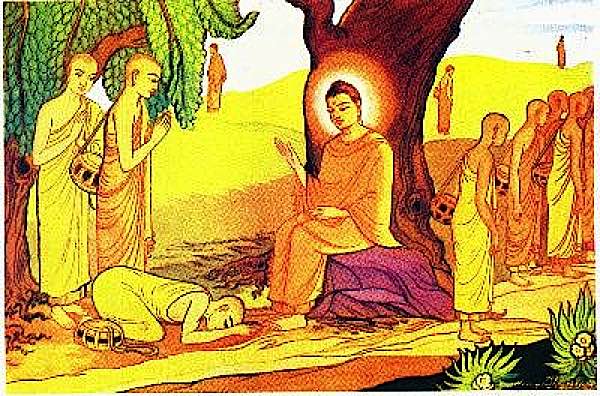
Thich Nhat Hanh, in his commentary in Awakening of the Heart: Essential Buddhist Sutras and Commentaries, elaborated with an example on the teachings on emptiness: “Many people think that the Buddha believed in nonbeing, annihilation, the destruction of feelings and intensions, and the dissolution of identities. This isn’t so. The Buddha taught that we must go beyond pairs of opposites, such as being and non-being, becoming and annihilation.”
The famous story of the woman and the raft

“This sutra is full of openness, playfulness, and non attachment from views. In reminding us to use great care and skill while studying and practicing his teachings, the Buddha uses another wonderful parable. He reminds us that if we use a raft to cross a river, we need to give up the raft when we’ve made it to the other shore. Instead of continuing to carry it with us, we leave it on the shore for others to use.”
In the Sutra, Buddha used one of the most famous Buddhist parables, the woman and the raft. Desperate to cross the river, a woman builds a raft and with great difficulty arrives on the other shore — metaphorically representing the difficult journey into the Dharma towards the destination of realizations, and ultimately Enlightenment. But, Buddha cautioned His students:
BUT, AFTER ARRIVING ON THE OTHER SIDE, SHE THINKS, ‘I SPENT A LOT OF TIME AND ENERGY BUILDING THIS RAFT. IT IS A PRIZED POSSESSION, AND I WILL CARRY IT WITH ME AS I CONTINUE MY JOURNEY.’ IF SHE PUTS IT ON HER SHOULDERS OR HEAD AND CARRIES IT WITH HER ON LAND, BHIKSHUS, DO YOU THINK THAT WOULD BE INTELLIGENT?”
The bhikshus replied, “No, World-Honored One.”
The Buddha said, “How could she have acted more wisely? She could have thought, ‘This raft helped me get across the water safely. Now I will leave it at the water’s edge for someone else to use in the same way.’ Wouldn’t that be a more intelligent thing to do?”

Buddha was explaining to his students that they shouldn’t remain attached to the very teachings that took them to Enlightenments Shore. Thich Nhat Hanh explained, “It is necessary to let go of all the true teachings, no to mention teachings that are not true. This is the spirit we need if we want to understand the Buddha’s teachings.
“May the Sutra of Knowing the Better Way to Catch a Snake sweep away the fog of words and notions in us so that the sun of the true teaching can shine brightly on the field of our understanding mind.”
Misunderstanding the Buddha’s teachings
Bhikshu Arittha was willful on more than one occasion. He had previously been suspended from the order for teaching or speaking wrong views. Prior to that, in the Arittha Sutta (Pali Canon) Artittha is the first to say he understands the Buddha’s teachings on mindfulness of breathing, when it’s clear he does not.
“I have the feeling that although Bhikshu Arittha was willful, he was non unintelligent,” explained Thich Nhat Hanh in his commentary. “In my opinion, Arittha’s misunderstanding stems from his failure to see the difference between attachment to sense pleasures and the joy and happiness that arise from a peaceful mind. On many occasions, the Buddha taught that joy and happiness are nourishing to us, while indulging in the sense pleasures can cause us suffering.” In other words, pleasures themselves are not the cause of suffering, but attachment to them is.
He adds, “But the practice of the Dharma does not exclude the enjoyment of the fresh air, the setting sun, a glass of cool water, and an appreciation of family and friends. Enjoying things in moderation doesn’t bring us suffering or tie us with the bonds of attachment. Once we recognize these things are impermanent, we have no problem enjoying them. In fact, real peace and joy are only possible when we see clearly into the nature of impermanence.”
Yet, it is equally true that the Buddha spoke of the five sense pleasures (money sex, fame, overeating, and sleeping too much) as “obstacles to the practice.”
As always, the Buddha taught the middle way. “If we get a reasonable amount of sleep every night, that cannot harm our practice. In fact, deep and refreshing sleep will help our practice. But if we spend a large part of each day sleeping, that is an obstacle.” Precious human birth is short, the journey to Enlightenment is long.
“It is possible that Bhikshu Arittha was unable to draw a line between the joy and happiness of a peaceful mind and indulging in sense pleasures,” postulates Thich Nhat Han.
[Full Sutra Knowing the Better Way to Catch a Snake below]
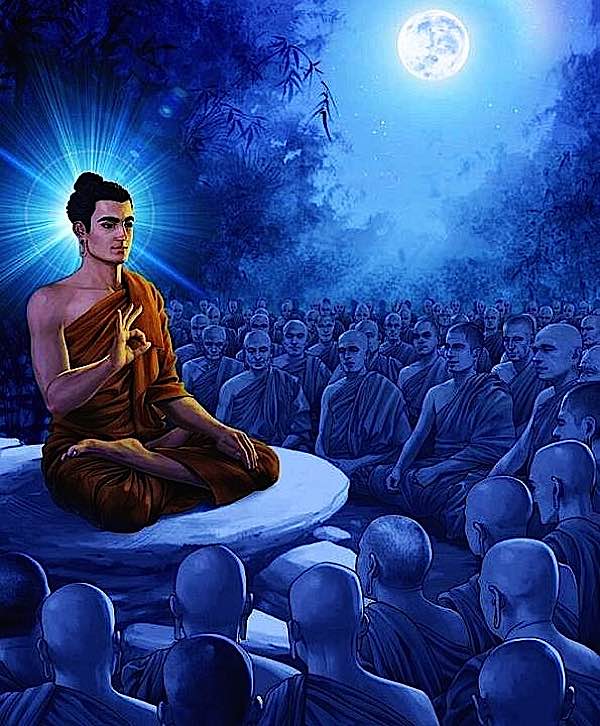
Sutra on Knowing the Better Way to Catch a Snake
I heard these words one time when the Buddha was staying at the Anathapindika Monastery in the Jeta Grove, near Shravasti. At that time, the Bhikshu Arittha, who before being ordained had been a vulture trainer, had the wrong view that according to the teachings of the Buddha, sense pleasures are not an obstacle to the practice. After hearing this, many bhikshus went to Arittha and asked, “Brother Arittha, do you really believe that the Buddha teaches that sense pleasures are not an obstacle to the practice?”
Arittha replied, “Yes, friends, it is true that I believe the Buddha does not regard sense pleasures as an obstacle to the practice.”
The bhikshus scolded him, “Brother Arittha, you misrepresent the Buddha’s teachings and even slander him. The Lord has never said that sense pleasures are not an obstacle to the practice. In fact, he uses many examples to teach that sense pleasures are an obstacle to the practice.
You should abandon your wrong view.” Although the bhikshus counseled Arittha in this way, he was not moved to change his view. Three times they asked him to abandon his wrong view, and three times he refused, continuing to say that he was right and the others were wrong.
Having advised him like this to no effect, they stood up and left. They went to the Buddha and recounted all that they had seen and heard.
The Buddha summoned Arittha, admonished him, and taught all of the bhikshus, “Monks, it is important to understand my teachings thoroughly before you teach or put them into practice. If you have not understood the meaning of any teaching I give, please ask me or one of the elder brothers in the Dharma or one of the others who is excellent in the practice about it.
“There are always some people who do not understand the letter or the spirit of a teaching and, in fact, take it the opposite way of what was intended, whether the teachings are offered in the form of verse or prose, predictions, verse summaries, interdependent origination, similes, spontaneous utterances, quotations, stories of previous births, wonderful occurrences, detailed commentaries, or clarifications with definitions.
“There are always some people who study only to satisfy their curiosity or win arguments, and not for the sake of liberation. With such a motivation, they miss the true spirit of the teaching. They may go through much hardship, endure difficulties that are not of much benefit, and eventually exhaust themselves.
“Bhikshus, a person who studies that way can be compared to a man trying to catch a poisonous snake in the wild. If he reaches out his hand, the snake may bite his hand, leg, or some other part of his body. Trying to catch a snake that way has no advantages and can only create suffering.
“Bhikshus, understanding my teaching in the wrong way is the same. If you do not practice the Dharma correctly, you may come to understand it as the opposite of what was intended. But if you practice intelligently, you will understand both the letter and the spirit of the teachings and will be able to explain them correctly. Do not practice just to show off or argue with others. Practice to attain liberation, and if you do, you will have little pain or exhaustion.

“Bhikshus, an intelligent student of the Dharma is like a man who uses a forked stick to catch a snake. When he sees a poisonous snake in the wild, he places the stick right below the head of the snake and grabs the snake’s neck with his hand. Even if the snake winds itself around the man’s hand, leg, or another part of his body, it will not bite him. This is the better way to catch a snake, and it will not lead to pain or exhaustion.
“Bhikshus, a son or daughter of good family who studies the Dharma needs to apply the utmost skill to understanding the letter and the spirit of the teachings. He or she should not study with the aim of boasting, debating, or arguing, but only to attain liberation. Studying in this way, with intelligence, he or she will have little pain or exhaustion.
“Bhikshus, I have told you many times the importance of knowing when it is time to let go of a raft and not hold onto it unnecessarily. When a mountain stream overflows and becomes a torrent of floodwater carrying debris, a man or woman who wants to get across might think, ‘What is the safest way to cross this floodwater?’ Assessing the situation, she may decide to gather branches and grasses, construct a raft, and use it to cross to the other side.
But, after arriving on the other side, she thinks, ‘I spent a lot of time and energy building this raft. It is a prized possession, and I will carry it with me as I continue my journey.’ If she puts it on her shoulders or head and carries it with her on land, bhikshus, do you think that would be intelligent?”
The bhikshus replied, “No, World-Honored One.”
The Buddha said, “How could she have acted more wisely? She could have thought, ‘This raft helped me get across the water safely. Now I will leave it at the water’s edge for someone else to use in the same way.’ Wouldn’t that be a more intelligent thing to do?”
The bhikshus replied, “Yes, World-Honored One.”
The Buddha taught, “I have given this teaching on the raft many times to remind you how necessary it is to let go of all the true teachings, not to mention teachings that are not true.”
~
“Bhikshus, there are six bases for views. This means that there are six grounds of wrong perception that we need to drop. What are the six?
“First, there is form. Whether belonging to the past, the future, or the present, whether it is our own form or the form of someone else, whether subtle or gross, ugly or beautiful, near or far, such form is not mine, is not me, is not the self. Bhikshus, please look deeply so that you can see the truth concerning form.
“Second, there are feelings.
“Third, there are perceptions.
“Fourth, there are mental formations. Whether these phenomena belong to the past, the future, or the present, whether they are our own or someone else’s, whether they are subtle or gross, ugly or beautiful, near or far, such phenomena are not mine, are not me, are not the self.
“Fifth, there is consciousness. Whatever we see, hear, perceive, know, mentally grasp, observe, or think about at the present time or any other time is not ours, is not us, is not the self.
“Sixth, there is the world. Some people think, ‘The world is the self. The self is the world. The world is me. I will continue to exist without changing even after I die. I am eternal. I will never disappear.’ Please meditate so you can see that the world is not mine, is not me, is not the self. Please look deeply so you can see the truth concerning the world.”
~
Upon hearing this, one bhikshu stood up, bared his right shoulder, joined his palms respectfully, and asked the Buddha, “World-Honored One, can fear and anxiety arise from an internal source?”
The Buddha replied, “Yes, fear and anxiety can arise from an internal source. If you think, ‘Things that did not exist in the past have come to exist, but now no longer exist,’ you will feel sad or become confused and despairing. This is how fear and anxiety can arise from an internal source.”
The same bhikshu then asked, “World-Honored One, can fear and anxiety from an internal source be prevented from arising?”
The Buddha replied, “Fear and anxiety from an internal source can be prevented from arising. If you do not think, ‘Things that did not exist in the past have come to exist, but now no longer exist,’ you will not feel sad or become confused and despairing. This is how fear and anxiety from an internal source can be prevented from arising.”
“World-Honored One, can fear and anxiety arise from an external source?”
The Buddha taught, “Fear and anxiety can arise from an external source. You may think, ‘This is a self. This is the world. This is myself. I will exist forever.’ Then if you meet the Buddha or a disciple of the Buddha who has the understanding and intelligence to teach you how to let go of all views of attachment to the body, the self, and the objects of the self with a view to giving up pride, internal knots (samyojana), and energy leaks, and you think, ‘This is the end of the world. I have to give up everything. I am not the world. I am not me. I am not the self. I will not exist forever. When I die, I will be completely annihilated. There is nothing to look forward to, to be joyful about, or to remember,’ you will feel sad and become confused and despairing. This is how fear and anxiety can arise from an external source.”
~
The Buddha asked, “Bhikshus, do you think the Five Aggregates and the self are permanent, changeless, and not subject to destruction?”
“No, reverend teacher.”
“Is there anything you can hold onto with attachment that will not cause anxiety, exhaustion, sorrow, suffering, and despair?”
“No, reverend teacher.”
“Is there any view of self in which you can take refuge that will not cause anxiety, exhaustion, sorrow, suffering, and despair?”
“No, reverend teacher.”
“Bhikshus, you are quite correct. Whenever there is an idea of self, there is also an idea of what belongs to the self. When there is no idea of self, there is no idea of anything that belongs to the self. Self and what belongs to the self are two views that are based on trying to grasp things that cannot be grasped and to establish things that cannot be established.”
“Such wrong perceptions cause us to be bound by internal knots that arise the moment we are caught by ideas that cannot be grasped or established and have no basis in reality. Do you see that these are wrong perceptions? Do you see the consequences of such wrong perceptions in the case of Bhikshu Arittha?”
~
The Buddha continued, “If, when he considers the six bases for wrong views, a bhikshu does not give rise to the idea of ‘I’ or ‘mine,’ he is not caught in the chains of this life. Since he is not caught in the chains of this life, he has no fear. To have no fear is to arrive at nirvana. Such a person is no longer troubled by birth and death; the holy life has been lived; what needs to be done has been done; there will be no further births or deaths; and the truth of things as they are is known. Such a bhikshu has filled in the moat, crossed the moat, destroyed the enemy citadel, unbolted the door, and is able to look directly into the mirror of highest understanding.
“Bhikshus, that is the Way of the Tathagata and those who have attained liberation. Indra, Prajapati, Brahma, and the other gods in their entourage, however hard they look, cannot find any trace or basis for the consciousness of a Tathagata. The Tathagata is a noble fount of freshness and coolness. There is no great heat and no sorrow in this state. When recluses and brahmans hear me say this, they may slander me, saying that I do not speak the truth, that the monk Gautama proposes a theory of nihilism and teaches absolute nonexistence, while in fact living beings do exist. Bhikshus, the Tathagata has never taught the things they say. In truth, the Tathagata teaches only the ending of suffering in order to attain the state of non-fear. If the Tathagata is blamed, criticized, defamed, or beaten, he does not care. He does not become angry, walk away in hatred, or do anything in revenge. If someone blames, criticizes, defames, or beats the Tathagata, how does he react? The Tathagata thinks, ‘If someone respects, honors, or makes offerings to a Tathagata, the Tathagata would not on that account feel pleased. He would think only that someone is doing this because the Tathagata has attained the fruits of awakening and transformation.’ ”
Having heard the Buddha speak thus, the bhikshus, with great joy, put the teachings into practice.
Arittha Sutra, Madhyama Agama 220
Alagaddupama Sutta, Majjhima Nikaya 22
More articles by this author

Samantabhadra’s The King of Prayers is the ultimate Buddhist practice how-to and itself a complete practice

The Five Strengths and Powers or pañcabalā in Buddhism — the qualities conducive to Enlightenment: faith, energy, mindfulness, concentration and wisdom
Search
Latest Features
Please support the "Spread the Dharma" mission as one of our heroic Dharma Supporting Members, or with a one-time donation.
Please Help Support the “Spread the Dharma” Mission!

Be a part of the noble mission as a supporting member or a patron, or a volunteer contributor of content.
The power of Dharma to help sentient beings, in part, lies in ensuring access to Buddha’s precious Dharma — the mission of Buddha Weekly. We can’t do it without you!
A non-profit association since 2007, Buddha Weekly published many feature articles, videos, and, podcasts. Please consider supporting the mission to preserve and “Spread the Dharma." Your support as either a patron or a supporting member helps defray the high costs of producing quality Dharma content. Thank you! Learn more here, or become one of our super karma heroes on Patreon.
Lee Kane
Author | Buddha Weekly
Lee Kane is the editor of Buddha Weekly, since 2007. His main focuses as a writer are mindfulness techniques, meditation, Dharma and Sutra commentaries, Buddhist practices, international perspectives and traditions, Vajrayana, Mahayana, Zen. He also covers various events.
Lee also contributes as a writer to various other online magazines and blogs.









